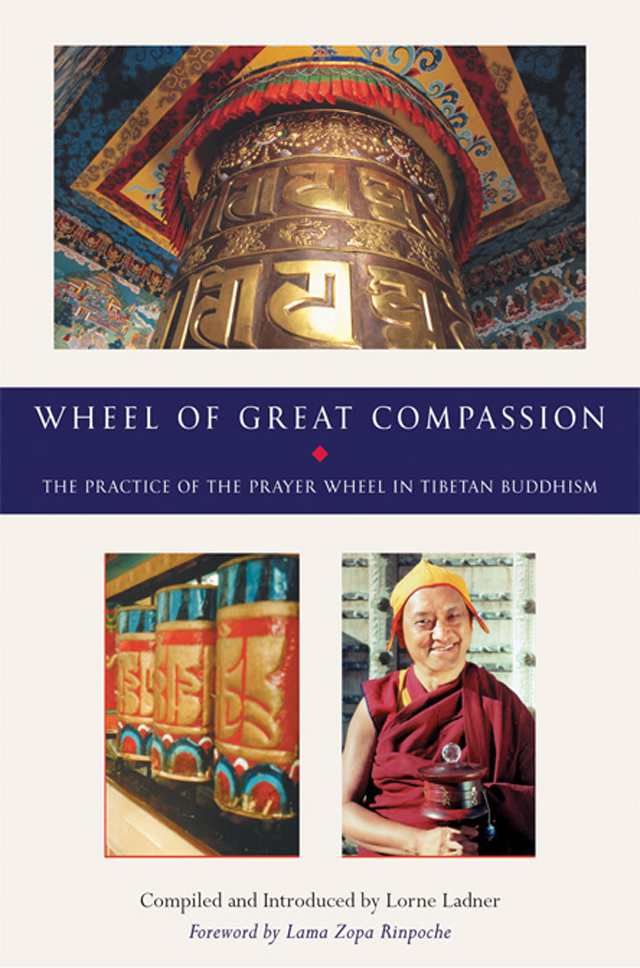Extract from: Wheel of Great Compassion: The Practice of the Prayer Wheel in Tibetan Buddhism, compiled and introduced by Lorne Ladner
Book Extract
In this book about Tibetan prayer wheels, Lorne Ladner gives a moving account of his experience with Lama Zopa Rinpoche, teacher to the Dalai Lama.

Book cover of Wheel of Great Compassion
The first time I can recall turning a prayer wheel was during our pilgrimage at the Great Stupa of Boudhanath in the Kathmandu valley of Nepal. Boudhanath is an ancient holy place; the Great Stupa sits, majestic as the Buddha himself. Serene Buddha - eyes painted on each of the four sides of an upper level of the stupa seemed to watch compassionately as prayer flags flutter, children scurry, Tibetan yogis meditate silently, tourists buy tea and buddha statues from shopkeepers, and faithful pilgrims continually circumambulate while turning hand-held prayer wheels or any of the hundreds of metal prayer wheels that have been installed along the outer edge of the stupa.
On our first day or so in Boudhanath, I went to visit the monastery of His Eminence Chogye Trichen Rinpoche, one of the greatest living Tibetan meditation masters and a teacher to His Holiness the Dalai Lama. I’d met His Eminence a few years earlier when he’d visited the United States, and he’d told me to come visit him if I was ever in Nepal. His monastery formed part of he wall of buildings that surround the Great Stupa. We sat for a while listening to a teaching His Eminence was giving in Tibetan. The walls of the assembly hall were painted with beautiful portraits of lamas from the monastery’s lineage. The room was crowded with Tibetan lamas, monks and lay people. I remember that I was sitting next to a Tibetan who continually turned what looked like an ancient hand-held prayer wheel. Later, as we were leaving the monastery, I paused to peer into a darkened room just by the monastery gate. A middle-aged Tibetan father suddenly pointed at me. “Hey you,” he called out, gesturing for me to enter. Inside was a giant, very beautiful prayer wheel; it must have stood eight or twelve feet high, with a diameter of five or six feet. It was turning slowly; the father seemed concerned about children who were trying to turn the wheel but were slipping. At his command, the children stepped back. He gestured for me to help and began turning the wheel. We got the wheel turning at a steady pace. With each rotation, a bell on the ceiling rang. The children laughed and Theresa smiled.
… During his month of teachings, Lama Zopa Rinpoche showed great patience and care as he led hundreds of students from around the world through the vast and profound passes and marvellous peaks in the mountains of Buddhist thought.
Around the end of the first week, Theresa and I had the opportunity to meet privately with him one evening in his small room atop the temple. The atmosphere in this room where he meditated was otherworldly - very pure, so that I felt both calmer and more joyful than I could recall ever having felt previously. I was deeply struck by Rinpoche’s great kindness and mindfulness during our meeting. Although he himself was fasting, he offered us a number of drinks and gourmet snacks not easy to find in Nepal, while answering our many questions. I recall at one point his stopping to have Theresa help him move a small insect from the floor where he feared it might get stepped on - as the Buddha taught: Harm not a single living being.
Late that evening, Lama Zopa Rinpoche began talking to us about prayer wheels. He explained that as a young boy he’d often wondered why so many older people spun prayer wheels. He told us the story of his long search for a text on the benefits of this practice and of how he’d eventually found a lama who had such a text. The text that this lama lent to him is the first of the translations that appear in this book. Lama Zopa Rinpoche explained that on reading this text and understanding the benefits of this practice, he had placed the text atop his head and vowed to Avalokiteshvara, the Buddha of Compassion, that he would spread this practice everywhere.
(Wheel of Great Compassion: The Practice of the Prayer Wheel in Tibetan Buddhism, compiled and introduced by Lorne Ladner, pub Wisdom Publications 2000)




